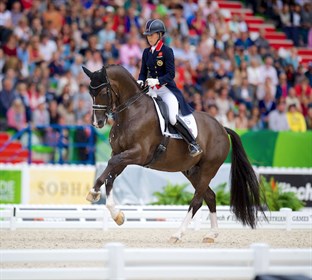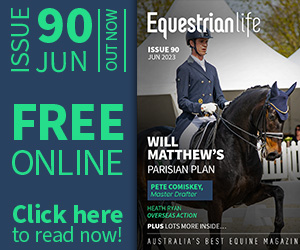
This article has appeared previously with Equestrian Life. To see what's in our latest issue, click here.
Charlotte Dujardin and Valegro.
© FEI/Arnd Bronkhorst/Pool Pic
Excellent performance in any human endeavour is based on preparation. Training to maximise your marks in the dressage arena is no exception. That perfect preparation is only achieved through practise.
BY KERRY MACK
DRESSAGE TRAINING IS a good basis for any riding horse, with the emphasis on training to improve balance, flexibility and obedience. Good training - training with integrity - is the best way to maximise marks. However, for those of us who want to compete in dressage, some of the training should include training to actually ride the test. Of course, most of the training to improve the test marks will just be the normal training you do, because the tests are about evaluating the training. Remember the fundamentals the judges are looking for. The score for any movement will reflect the score for the basic pace within the movement. To get an eight for a shoulder-in you have to trot for an eight within the shoulder-in. The training scale is a guide for the judges, too. Rhythm, suppleness, contact, impulsion, straightness and collection are all evaluated. Don't try to adjust what you do to suit what you think a certain judge likes. Train with integrity. Ride tests with integrity. Don't ride for the scoreboard. However, if you keep in mind the tests that are you going to ride, and the judging guidelines, you and your horse will be better prepared.
The rider should be prepared
First, get to know the tests really well. You don't want to be using all your mental energy in the ring remembering where to go. You need to know the test well enough that if your attention is taken up by something else you can still pick up the test. For instance, if he spooks at something you will probably focus on riding and the test won't be foremost in your mind. So once you have dealt with the spook you need to be able to know what to do next. Learn the test off the horse. Recite it, draw it, go over it in your head while you are doing something else, use imagery and ride it in your mind, have it videoed and watch it. Then ride it in your mind in the arena you are going to perform it.
When you are riding at home, try to pick up the test randomly. For example, if you are preparing to ride the 3.1 on the weekend and you are trotting around the arena on the left rein coming towards C, you can think, “OK, what do I do next if this was the 3.1?” The answer is halt at C, rein back. You should also ride the whole test sometimes, as there will be things you don't notice just by reading it. Something might come up pretty quickly, or might need preparation you hadn't thought of. I remember the first time I rode the Grand Prix, we were doing passage towards E, and realising that I had never done the transition from passage to canter, and noticing that actually it wasn't just as easy trot to canter. Luckily Pzazz is incredibly balanced and obedient and it was fine, but it was a moment of panic I can still remember years later. Sometimes you should ride the test and imagine that you are at the showgrounds in test conditions. Imagine the judge at C. You may find that even the imaginary pressure will lead to tension and mistakes and will help you prevent these in the ring. Practise breathing the tension out and staying calm. Accuracy is really important. Know the landmarks for your movements. For example, a three-loop serpentine has only one step on the long side at E or B. A 10-metre circle will just touch the centreline.
Kerry Mack and Mayfield Miracle.
© Michelle Terlato
Your horse should be prepared
Familiarise him with the lines in the test. Long before you enter any competitions you should both know the lines of the tests at your next level, and include these lines in training. Then connect two or three lines. Don't always ride the whole test, just parts of it. You don’t want him to anticipate the movements, or for it to become stale. Make sure you also ride lines that are not in the test and, as you go up to the higher-level tests, make sure that you often ride the lines without the movements. For example, canter up the diagonal just straight and rhythmical with little transitions within the pace, without doing the tempi changes or extended canter or the pirouettes. Ride the preparations for the movement but don't do the movement. For example, prepare for a canter pirouette by shortening the canter and getting into shoulder fore, but then continue straight. Quite often the horse will learn, for instance, that a pirouette is coming up and will take over, dropping the shoulder and spinning. Or if he is expecting the extended paces, he might take over and run, thus often losing balance. Don't lengthen stride for the whole line. For example, on the diagonal lengthen to X, then rebalance and go again. Ride past the marker before you do the change (e.g. the flying change at C in the PSG) or do canter to walk but stay in walk for 8-10 steps before you pick up the canter again in the simple change. Firstly, teach at home what the movement is, but then explain that he must wait to be asked and can't guess what is wanted and take over.
When training at home, practise correcting the mistakes that might happen in the ring. For example, in the shoulder-in vary the angle and vary the amount of bend, because in the ring you may not get the right amount straight off, and may need to get more or less bend or angle as you go along. Practise making the pirouettes (walk and canter) bigger and smaller as you may start too big and have to make it smaller, or he may offer it too small and you may want to make it bigger. Make it bigger by pushing the hindquarters out within the pirouette. Not easy but it's necessary to be able to do this sometimes.
Remember, the short side is where the preparation takes place. In your training, remember the corners and the short sides are important. Don't treat the short sides as nothing. This is where the judge gets the clearest picture of the frame. Sometimes, go forwards on the long side, make the paces bigger and refresh them. Bend in the corners and use them to collect.
Steffen Peters and Legolas 92.
© StockImageServices.com
Specific tips
• X is home base. You want the horse to feel secure at X. Halt at X when you finish the work. Stand there for a while. After he has stood to attention for a while, let him look around a little. Get off him at X. You want him to go into a strange arena, halt at X and feel that this is familiar, so he is more likely to relax. Of course, he must trot straight out, no walk steps, but first he must stand. Never correct halt by stepping backwards. Practise the halt. A good, straight, square and sustained halt with a clean, straight depart tells the judge at the beginning that you are on the ball. If they can give you a high score for this they are more likely to give you a high score for something else. That's just how all our brains are wired together. Make a good first impression.
• Train the walk. Every time you walk do some free walk to medium walk transitions. Your horse must not think that picking up the reins at walk is a cue to trot. When warming up or having a walk break, do some diagonal lines and pick up the reins on the long side. Get into the habit of leaning back a tiny bit before you collect the walk so he can be surer that you are not asking for trot. We do tend to lean forwards when we ask for trot. When asking for the free walk, let the neck out, and then make the steps longer.
• Train the transitions down from extended to collected within a pace. Always let him know what is coming by leaning back a little bit before you ask him to come back. This helps him be less reliant on your rein aid. A little shoulder for position will help him to stay straight. Sometimes, at the end of the lengthening, ask for a very small circle. It must be small enough so that he is responsible for his own balance, maybe eight metres. Don't be rough, but insist that the circle is small. Don't allow him to balance on your hand as you ask for the circle. Turn and give the rein. After a few repetitions he will start to come back at the end of the long side, taking responsibility for his balance in a better frame.
You will find more specific tips in my blog at EQ Life’s website in a series of articles called "Training for an Eight". Enjoy your training and try to train in a way that the horse enjoys it too. Whether your focus is competitions or not, remember that a well-trained horse is likely to have a better life than a badly trained one.
Have fun,
Kerry.
This article has appeared previously with Equestrian Life. To see what's in our latest issue, click here.
READ THE LATEST NEWS ARTICLES HERE
https://www.equestrianlife.com.au/articles/Practise-to-perfection

